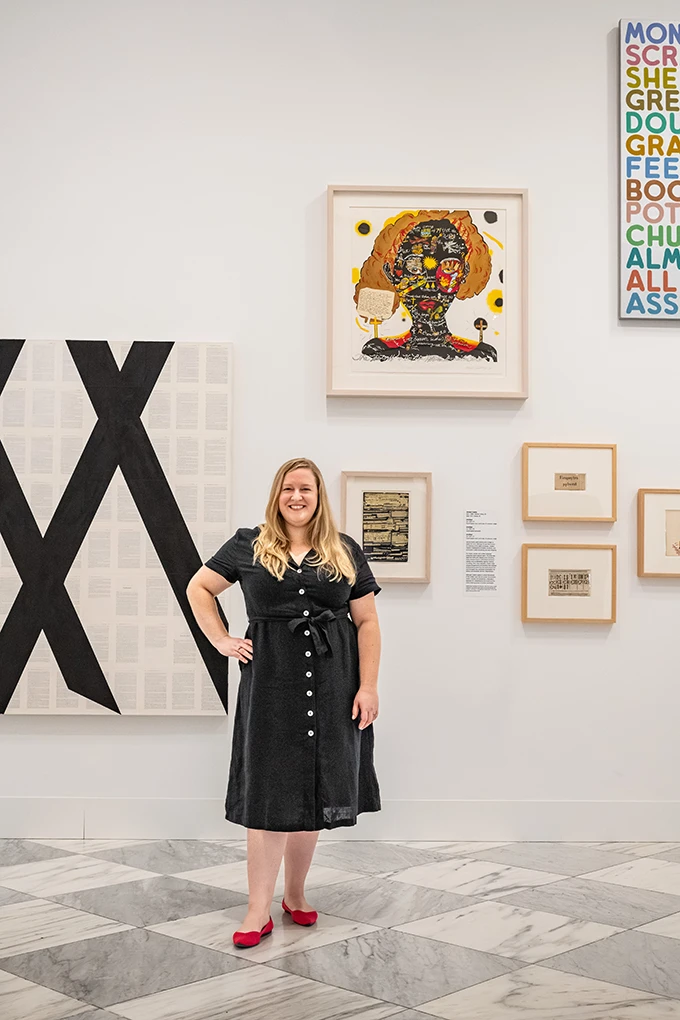Lily Christine Sehn Haviland, ’12, finds success on her artful career path
Loyola grad flourishes in hands-on museum work
 Photo by Olivia Bush
Photo by Olivia Bush
Lily Christine Sehn Haviland, ’12, grew up in a family passionate about travel and the arts. She spent countless hours in art museums and cultural venues throughout Europe and the United States, especially in Washington, D.C.—an hour from her hometown of Middleburg, Virginia.
So, when the time came for college, Haviland arrived at Loyola planning to study art history. On campus, Haviland took printmaking classes—an art practice she began in high school—and she carried that passion for artmaking into her studies.
Knowing that she wanted to find a career path that combines research and art museums, Haviland networked, sought opportunities, and tried working in different aspects of the museum world. She dabbled in development at the Patrons of the Arts in the Vatican Museums in Italy and educational programming at the Walters Art Museum in Baltimore.
After graduating with a bachelor’s in art history and minors in business entrepreneurship and studio arts from Loyola, Haviland went on to earn a Master of Art in Art History from American University, with the intention of keeping her career options in the museum world open. Being in the nation’s capital also enabled her to be surrounded by cultural institutions and near family. She was able to explore curatorial work at the Phillips Collection in Washington, D.C.
I participated in several service-learning classes, so Loyola is where I really started to make community engagement part of my life. Now, service has impacted how I think about the work I do.
Haviland was especially grateful to be close to home when her mom, Christine Sehn, fell ill during Haviland’s second year of graduate school. Even during this challenging time, Haviland’s family supported her dreams—including when she embarked on her graduate internship at the Smithsonian American Art Museum.
It was at the Smithsonian that Haviland discovered a love for hands-on registrar work, taking care of the works of art. In time, a position in the registrar’s office became available for the graphic arts collection—the perfect place for a printmaking enthusiast.
“It was a wonderful coincidence that a role opened for managing the works on paper. This job is a perfect fit,” said Haviland, who is now the museum’s collections manager of graphic arts and lives in Northwest Washington, D.C. with her wife, who also took the name Haviland upon marriage in honor of Lily’s maternal grandmother and great-aunt, who both have strong ties to Baltimore. “My job is making sure objects are safe for generations to come. My long-term goal is the preservation of art and culture for the country.”
Haviland’s civic-minded approach to her work stems in part from her parents’ belief in service—and from her time at Loyola.
“I participated in several service-learning classes, so Loyola is where I really started to make community engagement part of my life,” Haviland said. “Now, service has impacted how I think about the work I do. My work at a free museum is to ensure we’re making these beautiful artworks and cultural items available to everyone.”
Outside her job, Haviland stays involved in the community, volunteering at a D.C. women’s shelter for several years. Remembering the importance of internships and mentoring in her early career, Haviland pays it forward as a professional sponsor at the Rizzo Career Center and as a member of the Board of Advisors for Loyola College, the University’s school of arts and sciences.
Additionally, over the years, Haviland’s family has provided support for fine arts internships, scholarships, an programs at her alma mater. She and her father carry this tradition of giving forward by celebrating the legacy of her mother through the Lily and Christine Sehn Endowment.
Through it all, Haviland remains grateful for her Loyola experience.
My career wouldn’t have gotten started without the support of the visual arts department at Loyola, the exposure I had to Baltimore and the arts, and the studio arts and art history faculty members who were wonderful mentors to me.